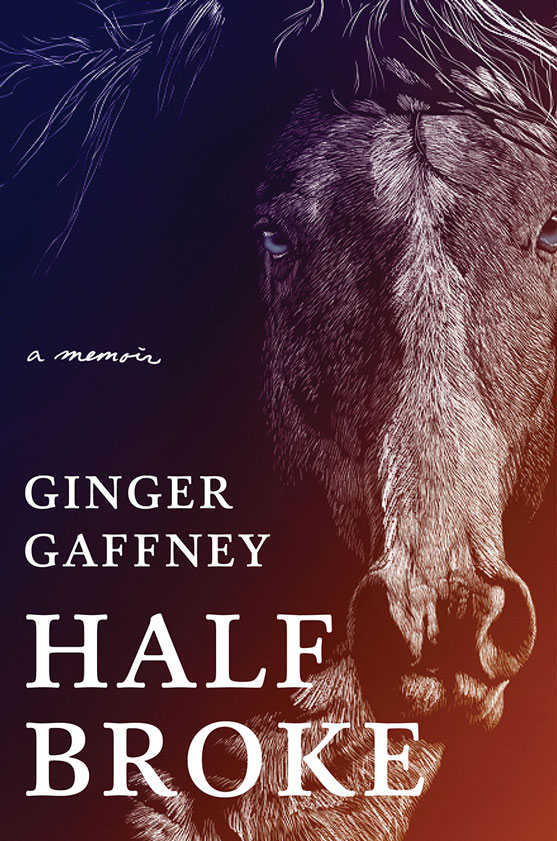

Welcome To
The James Museum from Home
Connect with us through curated content based on our collection. Explore art, movies, books, music, children’s activities and more. Each theme is freshly considered and developed by our curatorial and education teams. We invite you to discover a new way to experience the museum and learn more about our collection.
Theme: Spring
We welcome spring and its promise of new beginnings. Experience the vibrant signs of the season – birth, hope, renewal, growth, and redemption – through an array of art, movies, books, and family activities.
Selected Artwork
Take a look at six paintings that celebrate spring in all its colorful glory, with fresh palettes, symbols of new life, vitality, and cheer.
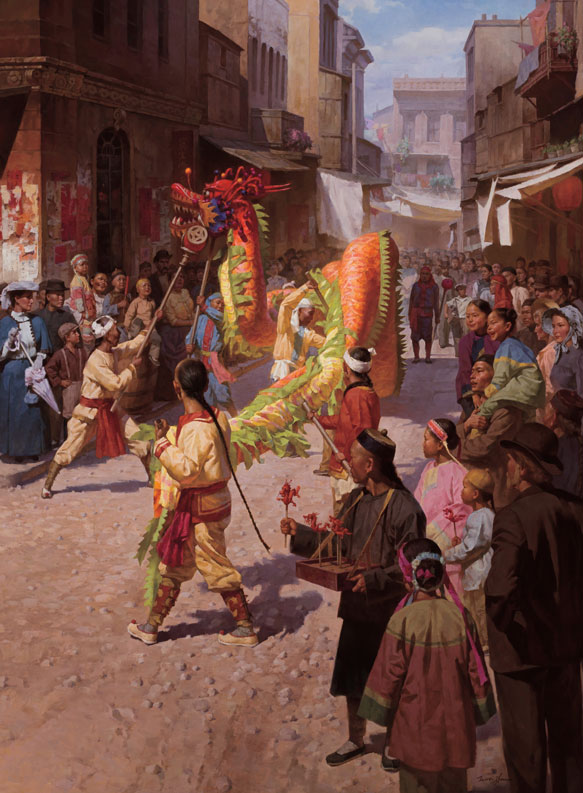
Jie Wei Zhou
Chinese American
born 1962
Dragon Parade
2012
Oil on linen
Art Spotlight
By: Jason M. Wyatt | Collections Manager
Chinese American artist Jie Wei Zhou transports the viewer to San Francisco in 1904 during the city’s celebration of the Chinese New Year, the year of the dragon. This Chinatown scene depicts a predominately Chinese crowd as they watch dancers wind their way down a packed street carrying a colorful cloth dragon.
The dragon dance originated over 2000 years ago during China’s Han Dynasty. This dance is performed during festive occasions such as the Chinese New Year to scare away evil spirits and bring good luck. The longer the dance during a celebration, the more luck it will bring to the community.
The celebration of the Chinese New Year begins on the first day of a new moon that occurs between January 21 and February 20. This celebration is also referred to as the Spring Festival if it falls between February 4-18, the short period of time on the lunar calendar whose name translates as the start of spring.
Painter Jie Wei Zhou began pursuing art in middle school, eventually earning his Bachelor of Arts degree from Shanghai Normal University. While at university, he studied French and Russian painting styles, which helped him strengthen his mastery of light and form. Soon after receiving his Master in Fine Art degree from the Shanghai Drama Institute, Zhou sent some paintings to a gallery in the United States. All the works sold, and the money he made paid for his move to the U.S. where he settled in Colorado.
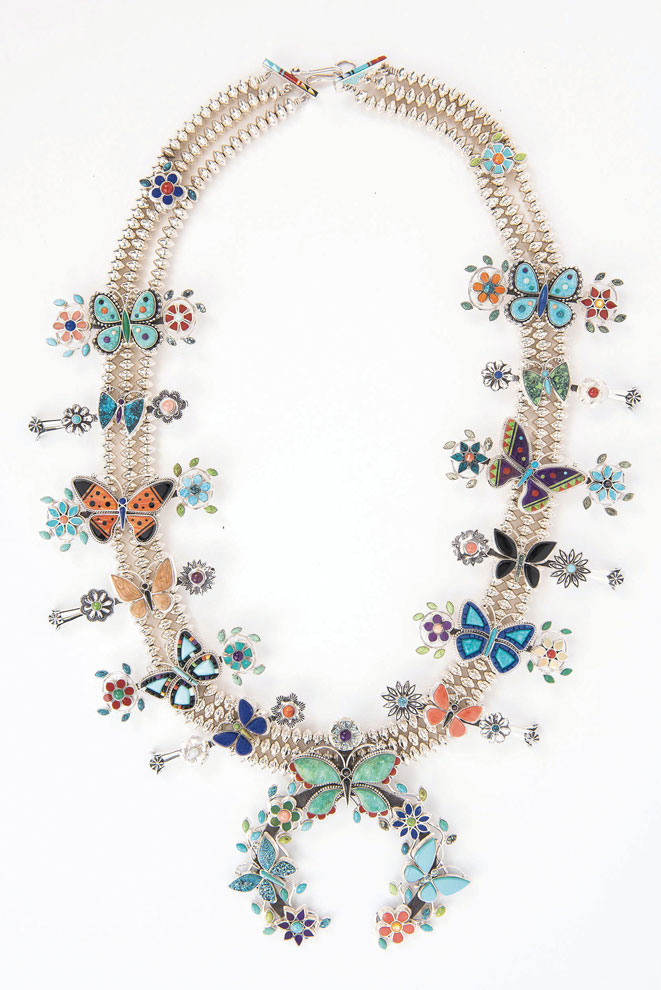
Ernest Benally
Navajo, born 1959
Butterfly Squash Blossom Necklace
2016
Sterling silver, eleven types of turquoise, three types of coral, black Acoma jet, lapis, chrysoprase, sugilite, gaspeite, Australian opal, gold lip mother-of-pearl, spiny oyster, white clam shell, black mother-of-pearl
Art Spotlight
By: Jason M. Wyatt | Collections Manager
The evolution of the squash blossom necklace began in the 17th century when the Navajo began acquiring the horseshoe-shaped naja pendants from the Spanish. These pendants were used on horse bridles to ward off “the evil eye” and were an influence on Spanish culture from Moorish conquests. Najas were worn on simple necklaces until strands of silver beads gained popularity in the late 1870s – early 1880s. From this point forward, the naja was suspended on these silver beaded necklaces. The term “squash blossom” is derived from the type of bead that looks like it is blossoming. These fancier beads were interspersed with the plain silver beads on necklaces. There is still a debate on whether the bead design was based on an actual squash blossom or the motif of a pomegranate found on Spanish military buttons.
Navajo jeweler Ernest Benally transformed the traditional design of the squash blossom necklace and modernized it here, adding butterflies and flowers using vibrant inlaid stones. The artist changed the “blossoming” bead into a butterfly. Each of these butterfly beads alternates with the typical silver blossom and a more elaborate realistic flower. The naja is historically made of silver, sometimes inlaid with turquoise, and Benally has transformed it with an array of butterflies, flowers, and vines. One can’t help but think of Spring when viewing this statement necklace.
Mary James commissioned this necklace in 2015 after seeing a similar piece by the artist during the Santa Fe Indian Market. In a letter to Tom and Mary James, the artist’s wife Veronica Benally states that the design of the necklace kept changing as the artist worked on the silver parts, “just like butterflies change.” The naja became larger than what is typical, the blossoms more detailed and the beaded necklace became three strands, a first for the artist. Every part of the necklace was handmade by Benally, from the sterling silver cords and beads to the hand cut stone and shell inlays.

Ron “R. S.” Riddick
American, born 1952
Rendezvous Welcome
2015
Gouache on paper
Art Spotlight
By: Caitlin Pendola | Curatorial Associate
The annual Rocky Mountain Rendezvous was, officially, a temporary trading station. Informally, it was a weeks-long party, and all because of hats. The fur trade had become a big, international business. Around 1800, most of this depended on the beaver. No man of style in Europe or the United States was without a beaver hat. Large fur and trading companies had set up trading posts in major cities, where the Native American Indians would travel by river to sell their pelts. The enterprise that would become known as the Rocky Mountain Fur Company saw an opportunity to cut out the middleman from the industry. Instead of trading with the Native Americans at stations in the East, they hired white men to live and trap for them in the western wilderness year-round. These men would quickly become known as mountain men, a glorified figure of the American West.
Many American Indians didn’t appreciate this new competition, and relations between mountain men and Native tribes varied. There were often amiable connections, with some of the white men marrying Indian women and being welcomed as family, while other relationships turned hostile and downright violent.
Once a year, during the warm months when travel was feasible, these mountain men, along with many American Indian tribes who had become dependent on non-native goods, would meet the trading companies at a designated site in the Rocky Mountain region. The trappers would sell their pelts in exchange for the trading companies’ supplies such as coffee, tobacco, horseshoes, and knives they needed for solitary life in the mountains.
This meet-up was quite the multicultural affair. The trappers were comprised of mostly German, French, Scottish and Irish, and Native tribes included Iroquois, Shawnee, Nez Perce, Delaware and others. These annual gatherings, that lasted from 1825 to 1840, were lively, social events with plenty of whiskey. For the mountain men, they were a welcome reprieve from the isolation of the wilderness. Despite the language barriers and cultural differences, the people found ways to communicate and celebrated this time together.
This depiction of a trapper riding into the Rocky Mountain Rendezvous by artist Ron Riddick won a gold medal at the Cowboy Artists of America 2015 show. As you can see with the springtime-like color palette, and the smiling faces, Riddick often enjoys interpreting the lighter moments in western themes. He has a talent for capturing the human message in his work and translates history with a romantic point of view.
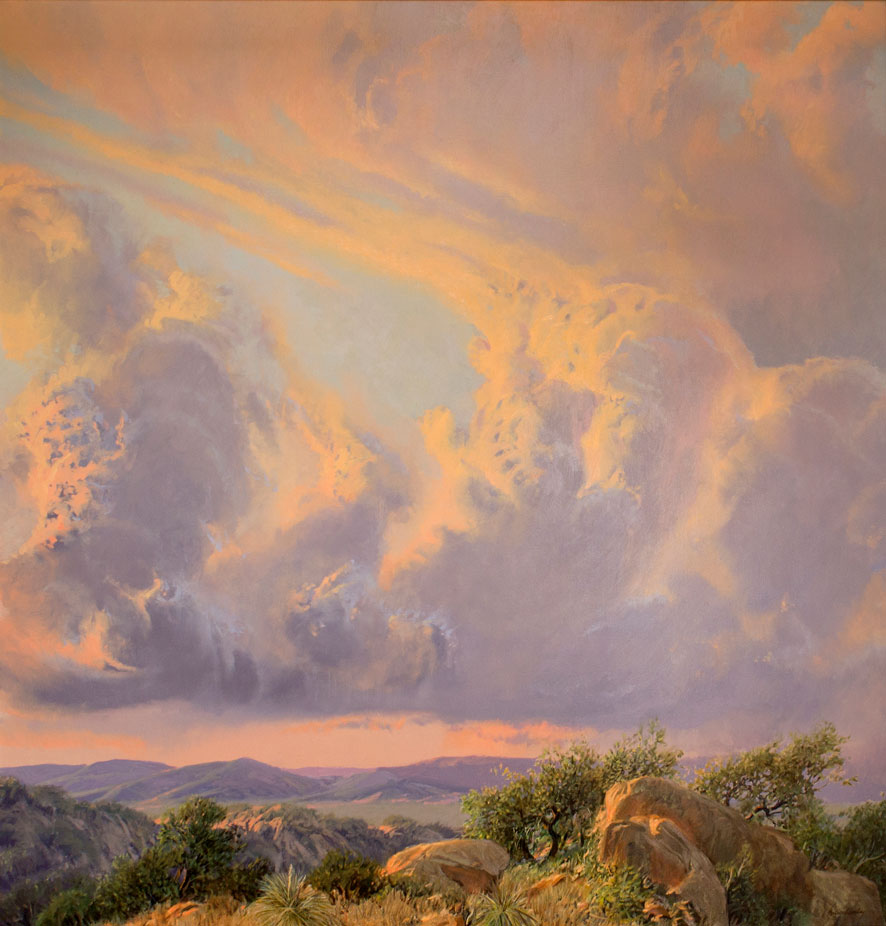
Wilson Hurley
American, 1924–2008
Morning Clouds
1988
Oil on canvas
Art Spotlight
By: Caitlin Pendola | Curatorial Associate
This pastel-colored sky is painted by Wilson Hurley, one of the most notable Western landscape artists of his time. However, “artist” is only one of his many titles, with many wide-ranging achievements. Hurley’s life was as accomplished as his landscape paintings were grand. His father served as the Secretary of War during the Hoover administration when Hurley was a boy. Following in those footsteps, Hurley became an Army pilot, serving in the South Pacific during World War II. Seeing the vast land from above eventually inspired many of his paintings. He also became a lawyer, engineer, husband, father, Vietnam veteran, and through it all, quietly developed his art. Not until his late 40s, did he make painting a career.
Hurley has often been compared to the Hudson River School painters because of his luminist style and emotionally charged landscapes of the West. Though the works of these 19th century artists have a strong sense of mystery and devoutness, an intentionally heavenly like aesthetic, Hurley’s approach was more scientific. He understood how atmosphere intercepts color, weather patterns, and how the laws of physics apply to the natural world. Notably, Hurley mostly taught himself physics, and he referred to himself as a “scientific painter.” His fascination led him to read every issue of Scientific American magazine ever published to learn what he could. This considerably helped him in his art, as he read articles on how humans see and process light, the chemistry of paint, what light does when it hits pigments and more. It is obvious when looking at his realistic rendering of clouds, such as here in Morning Clouds, that he brought this knowledge to the canvas. Hurley has the unique ability of doing a vista justice.
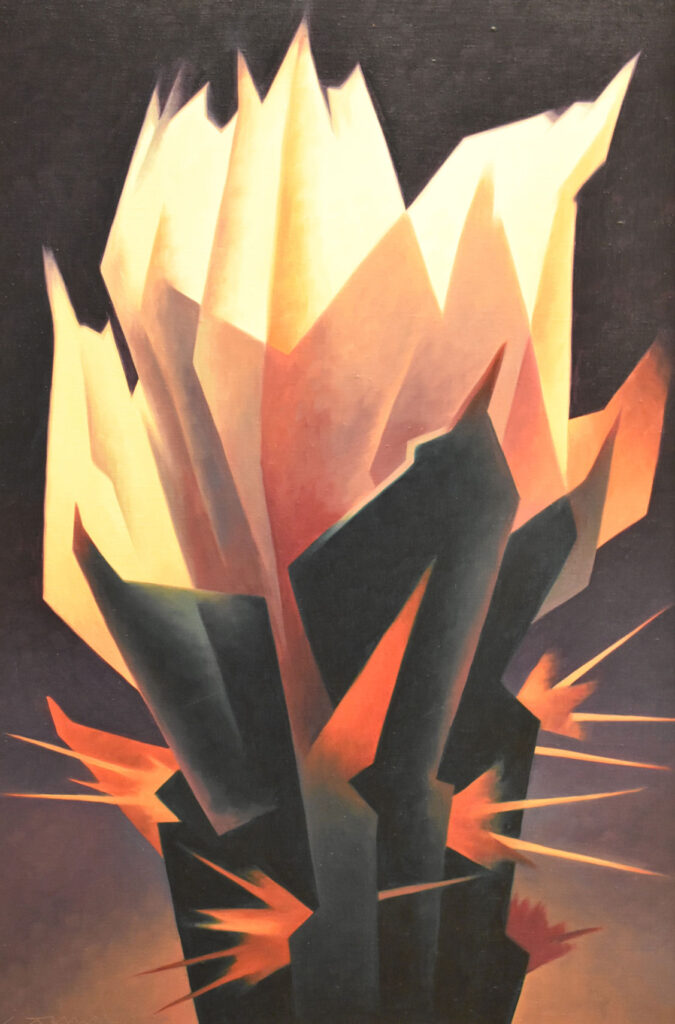
Ed Mell
American, born 1942
Nocturne Bloom
2005
Oil on canvas
Art Spotlight
Born and raised in Phoenix, Arizona, Ed Mell’s artistic eye was developed in Los Angeles at the Art Center College of Design and then in New York City, where he spent five years in advertising and freelance illustration. “When I was in New York,” Mell related in a Southwest Profile magazine interview, “the modern art movement was making a statement. I sort of reacted to that. I thought maybe it was time to do something else, to do something that’s handsome and romantic.”
Mell’s style is influenced by the sharp angles, bold geometric shapes, and multiple viewpoints of Cubism. He uses oil paints thinned with poppy seed oil, making the paint more fluid and creating a natural sheen on the canvas.
According to author Donald J. Hagerty in his book, Beyond the Visible Terrain: The Art of Ed Mell, “Mell turned to flower painting in order to cleanse his sight, so he might return to landscapes with renewed vigor and insight…He moved his viewpoint closer to the objects, and was thus able to break through their outline to reveal a different, more abstract quality.”
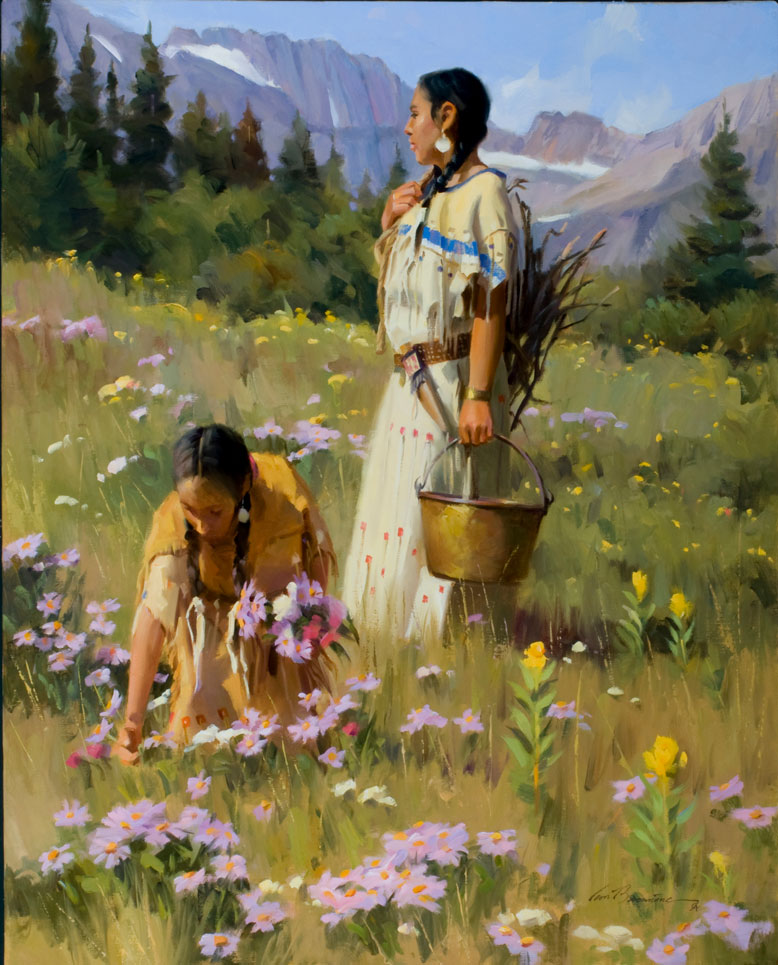
Tom Browning
American, born 1949
Among the Wildflowers
2010
Oil on linen
Art Spotlight
By: Caitlin Pendola | Curatorial Associate
Browning began his professional art career in 1972 and has not looked back. He has won many awards and honors, including induction into the Cowboy Artists of America in 2009. Even after going through two major brain surgeries, Browning has continued to produce art, believing he has created some of his best work since recovering.
Though known primarily for oil painting, he has worked in a variety of media. One of those is scratchboard, a black and white medium that he credits as being the foundation for his understanding of value and convincing sense of light. Browning has also experimented in a variety of subject matter. Santa Clause, ballet, landscapes, and still lifes are among the visited themes, but western subjects have been a constant. No matter the focus, Browning often depicts a quiet, simple slice of life, such as here with women picking wildflowers on a spring day.
The artist has used a number of techniques to create an idyllic, glowing scene. His loose brushwork makes the grassland appear soft. With the light blue sky and the yellow and pink flowers, he has utilized the triad color scheme, creating a sense of harmony with the hues. The simplicity of the forms, and how the light casts evenly over the composition, all adds to the creation of an almost dreamlike scene.
Books
The James Museum Book Club Recommends…
Half Broke
By Ginger Gaffney
Spring traditionally is a time for new life and new beginnings, but what if you are starting from a particularly dark place? Half Broke is a story about the transformative power of working with horses.
Ginger Gaffney found training horses healing for herself as well as for a group of recovering addicts living at an alternative prison ranch in northern New Mexico. The residents live a regimented life under threat of being returned to prison and not surprisingly, they have many issues, including anger, depression and lack of self-esteem. When Gaffney arrives on site, the horses have issues too; they’re extremely aggressive, injuring themselves and the residents. Working with the horses, the residents overcome fears, learn how to relate to people and animals and gain self-confidence.
The memoir also tells Gaffney’s personal story, beginning with her troubled childhood. She says she didn’t speak until she was six and always felt different and out of place. Training horses helped her find her place in life.
Ginger Gaffney is an author, a horse trainer, and teacher of riding and writing. She have been working with horses and their people for over 25 years.
Learn More About Horse Training
Clinton Anderson Presents Running Scared: Training an Aggressive Horse
Horse trainer Clinton Anderson shows a horsewoman how to gain the respect and trust of her aggressive horse. Learn how to train an aggressive horse. (24:53 min)
How to Make a Horse a Friend: One Cowboy’s Partnership with Horses
Jimmy Anderson, a cowboy and colt-starting champion, says that this meeting of minds between humans and horses is key. Anderson doesn’t believe in breaking horses; instead he “starts” them. He states, “Horses are really amazing at how much they will be a partner. They try a crazy amount, and I want to try that same amount back for them.” (9:49 min)
More Books
The Cactus League
By Emily Nemens
Jason Goodyear is the star outfielder for the Los Angeles Lions, stationed with the rest of his team in the punishingly hot Arizona desert for their annual spring training. Handsome, famous, and talented, Goodyear is nonetheless coming apart at the seams. And the coaches, writers, wives, girlfriends, petty criminals, and diehard fans following his every move are eager to find out why―as they hide secrets of their own. Humming with the energy of a ballpark before the first pitch, this book unravels the tightly connected web of people behind a seemingly linear game.
The Secret Lives of Color
By Kassia St. Clair
This book tells the unusual stories of 75 fascinating shades, dyes, and hues. From blonde to ginger, the brown that changed the way battles were fought to the white that protected against the plague, Picasso’s blue period to the charcoal on the cave walls at Lascaux, acid yellow to kelly green, and from scarlet women to imperial purple, these surprising stories run like a bright thread throughout history.
The author has turned her lifelong obsession with colors and where they come from into a unique study of human civilization.
Movies
Enjoy three light-hearted movies that highlight some of the best of spring, from butterflies to baseball.
Feature Films
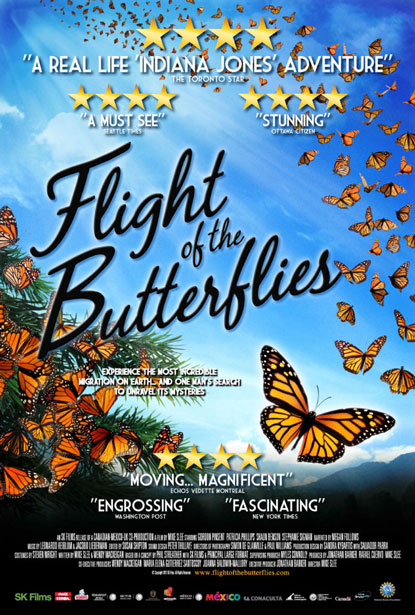
Flight of the Butterflies (2013)
The monarch butterfly is a true marvel of nature. Weighing less than a penny, it makes one of the longest migrations on Earth, crossing a continent to a place it has never known. Follow the monarchs’ perilous journey and join hundreds of millions of real butterflies in the remote mountain peaks of Mexico. Featuring breathtaking cinematography, this film explores the true and compelling story of an intrepid scientist’s 40-year search to find the monarchs’ secret hideaway. Rated G; 44 min.
The Battered Bastards of Baseball (2014)
Who could’ve imagined spring without baseball? If you’re pining for the game, check out this colorful true story set in Portland, Oregon. The Mavericks were a scrappy, independent team of underdogs started in 1973 by actor Bing Russell (best known for playing Deputy Clem on “Bonanza”). The only thing uniting his players, recruited at open tryouts, was that no other team wanted them. Skeptics thought it could never work. But they won games, and they won fans with their contagious spirit, shattering minor-league attendance records. Rated TV-MA; 80 min.

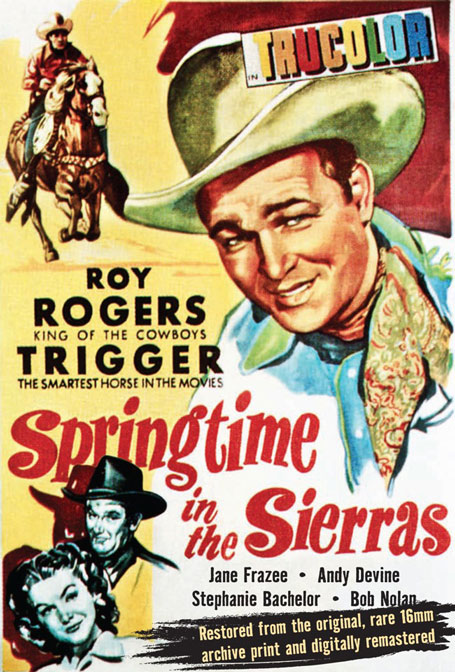
Springtime in The Sierras (1947)
This fun, action-packed B-Western stars Roy Rogers and his famous horse, Trigger. A singing cowboy (Rogers) and his sidekick (Andy Devine) band together to fight a gang of poachers, headed by the evil Stephanie Bachelor, who prey on the wildlife of a game preserve. R; 75 min.
Family activities
Story Time
Read along with these colorful and engaging stories.
Thank you Earth
By April Pulley Sayre
Chelsea’s Chinese New Year
By Lisa Bullard
Illustrated by Katie Saunders
Art Activities
Get creative with inspiration from artists and artwork in the museum’s collection. Share your creations with us and use #thejamesmuseum.
Clay Leaf Impression
Follow along to create a clay leaf impression using easy to find materials.
Color Wheel Challenge
Challenge yourself to make your own color wheel with items found around your house!
